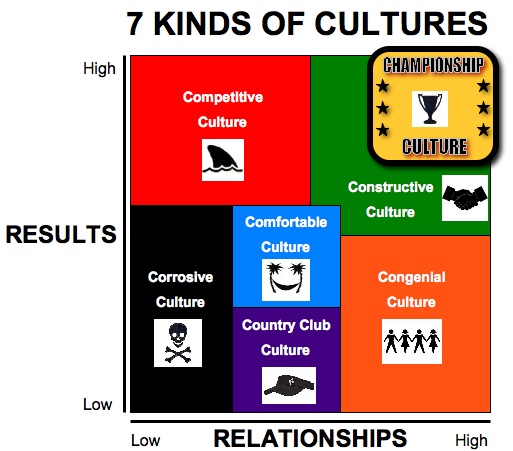1. Corrosive Culture
 A Corrosive Culture is highly toxic and is characterized by a lot of conflict, negativity, frustration, cliques, gossiping, distrust, and selfishness. It is obviously not one that is fun to be around and the turmoil and tension off the field/court almost surely affects the team on it. From a relationship standpoint, cliques will often develop that divide, distract, and destroy the team. Rather than battling your opponents, your athletes spend more time battling each other and the coaching staff because no one is on the same page working toward the same goal.
A Corrosive Culture is highly toxic and is characterized by a lot of conflict, negativity, frustration, cliques, gossiping, distrust, and selfishness. It is obviously not one that is fun to be around and the turmoil and tension off the field/court almost surely affects the team on it. From a relationship standpoint, cliques will often develop that divide, distract, and destroy the team. Rather than battling your opponents, your athletes spend more time battling each other and the coaching staff because no one is on the same page working toward the same goal.From a results standpoint, people become apathetic or even resistant toward team goals because they lose respect for their coaches and/or teammates. In Corrosive Cultures there is a lot of selfishness because in such a negative and dysfunctional environment, members basically must look out for themselves because they don’t trust their teammates and coaches. As the name suggests, Corrosive Cultures eat away at people’s attitudes, commitment, and chemistry much like a caustic acid. Ultimately, people just seek to endure in this kind of culture or escape it whenever possible.
2. Country Club Culture
 The Country Club Culture is one of entitlement, appearances, and leisure. The priority in this culture is to look good and to have a good time rather than to win championships. It is a superficial and soft culture where little accountability is expected from its members so people are allowed to coast. Playing time and leadership positions are often not based on merit but instead on politics, popularity, and brown-nosing. The currency in a Country Club culture of is much more about style than substance. Status in a Country Club Culture is accrued primarily by the kind of gear people wear. Results are clearly secondary and relationships are superficial at best.
The Country Club Culture is one of entitlement, appearances, and leisure. The priority in this culture is to look good and to have a good time rather than to win championships. It is a superficial and soft culture where little accountability is expected from its members so people are allowed to coast. Playing time and leadership positions are often not based on merit but instead on politics, popularity, and brown-nosing. The currency in a Country Club culture of is much more about style than substance. Status in a Country Club Culture is accrued primarily by the kind of gear people wear. Results are clearly secondary and relationships are superficial at best.3. Congenial Culture
 A Congenial Culture is one where the focus is primarily on getting along and preserving harmonious relationships. The group becomes more of a support group and social club rather than a high-performance team focused on achieving winning results. While most people get along, a Congenial Culture’s major concern is that it can be too nice and not focused enough on results. Members are very kind to each other but they are typically not honest and candid because they worry the truth might cause hurt feelings or strained relationships. A Congenial Culture fits well for a fraternity or sorority, but not as well for a competitive sports team.
A Congenial Culture is one where the focus is primarily on getting along and preserving harmonious relationships. The group becomes more of a support group and social club rather than a high-performance team focused on achieving winning results. While most people get along, a Congenial Culture’s major concern is that it can be too nice and not focused enough on results. Members are very kind to each other but they are typically not honest and candid because they worry the truth might cause hurt feelings or strained relationships. A Congenial Culture fits well for a fraternity or sorority, but not as well for a competitive sports team.4. Comfortable Culture
 A Comfortable Culture is one where results and relationships are of moderate importance. The team sets reasonable standards and is interested in doing well but not if it pushes them out of their comfort zone. They will train to certain level but once it gets tough or uncomfortable, as it does and should when you are trrying to be a championship program, they tend to back off, complain, and not push through the hard work of training. Similarly with relationships, the team generally gets along but there are few deep, enduring relationships. And there is not a collective sense of mission between the teammates. Comfortable Cultures usually produce mediocre results and teammates and coaches who end up being acquaintances rather than life-long, close friends and mentors when it is all said and done.
A Comfortable Culture is one where results and relationships are of moderate importance. The team sets reasonable standards and is interested in doing well but not if it pushes them out of their comfort zone. They will train to certain level but once it gets tough or uncomfortable, as it does and should when you are trrying to be a championship program, they tend to back off, complain, and not push through the hard work of training. Similarly with relationships, the team generally gets along but there are few deep, enduring relationships. And there is not a collective sense of mission between the teammates. Comfortable Cultures usually produce mediocre results and teammates and coaches who end up being acquaintances rather than life-long, close friends and mentors when it is all said and done.5. Competitive Culture
 In Competitive Cultures, there is a strong focus on results and minimal focus on relationships. The competitiveness is both external with opponents and internal with teammates. Team members spend a lot of time competing with each other for limited playing time, coaches’ attention, and leadership roles. While competition is necessary and can spur on great achievement, if taken overboard, the competitiveness can also inhibit or destroy relationships within the team itself. You do want a highly competitive team - but you also want them to collaborate and positively push each other.
In Competitive Cultures, there is a strong focus on results and minimal focus on relationships. The competitiveness is both external with opponents and internal with teammates. Team members spend a lot of time competing with each other for limited playing time, coaches’ attention, and leadership roles. While competition is necessary and can spur on great achievement, if taken overboard, the competitiveness can also inhibit or destroy relationships within the team itself. You do want a highly competitive team - but you also want them to collaborate and positively push each other.Talent is considered the ultimate in a Competitive Culture, whereas character and people skills are often neglected. In a Competitive Culture, oftentimes athletes are only valued for their athletic talent and disregarded if they are injured for a long time or don’t have the talent to contribute to the team. Because of the business nature of professional sports where athletes rarely spend time with each other away from the sport, many pro teams develop a Competitive Culture.
6. Constructive Culture
 A Constructive Culture has a solid level of focus on results and a satisfying focus on relationships. Team members are committed to being successful and are usually willing to put in the hard work necessary to achieve at the higher levels. From a relationship standpoint, teammates strive to get along with each other and develop a solid bond with each other. Although the Constructive Culture is positive, productive, and often successful on and off the playing fields, it falls short of the intense levels of commitment, chemistry, and accountability you see in a Championship Culture.
A Constructive Culture has a solid level of focus on results and a satisfying focus on relationships. Team members are committed to being successful and are usually willing to put in the hard work necessary to achieve at the higher levels. From a relationship standpoint, teammates strive to get along with each other and develop a solid bond with each other. Although the Constructive Culture is positive, productive, and often successful on and off the playing fields, it falls short of the intense levels of commitment, chemistry, and accountability you see in a Championship Culture.7. Championship Culture
 A Championship Culture places a premium on both results and relationships. From a results standpoint, Championship Cultures have a strong sense of mission and purpose. They know exactly what they want to achieve and have a burning desire to achieve it. They are fully designed and aligned to achieve their goals and are focused on them like a laser beam. They have very high standards for the team members and provide them with candid and frequent feedback on how they are doing.
A Championship Culture places a premium on both results and relationships. From a results standpoint, Championship Cultures have a strong sense of mission and purpose. They know exactly what they want to achieve and have a burning desire to achieve it. They are fully designed and aligned to achieve their goals and are focused on them like a laser beam. They have very high standards for the team members and provide them with candid and frequent feedback on how they are doing.In addition to results, Championship Cultures also highly value relationships. Team members are treated with respect and valued for their contributions to the team, whether large or small. Teammates take pride in their roles because they know their value to the team and feel appreciated for playing them. Leaders intentionally build strong relationships within the team to help people feel respected and perform to their potential. Because they feel appreciated and cared for as people, team members selflessly subvert their individual goals for the benefit of the entire team. They value and take immense pride in being a part of something that is much bigger than themselves. Not surprisingly then, Championship Cultures are typically highly successful both on and off the court/field.
So after reading through these seven kinds of cultures, which of these seven cultures best describes the current status of your team? Why?
If you are like many coaches and find that your present culture is not your preferred culture, what can you do to change and transform it?
No comments:
Post a Comment